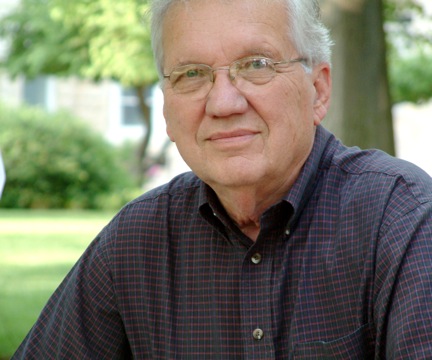After a term with the Mennonite Central Committee in Akron, Pennsylvania my wife, Vernette, and I headed to our first urban immersion. We arrived in Chicago in the late summer of 1955. Preferring a bit of security in the face of a new, intimidating environment we sought a degree of familiarity by opting for housing that was available at the Mennonite Seminary on South Woodlawn. This is where Sylvia’s journey and our journey intersected.
Sylvia had just completed seminary work and was ready, as was I, to start her first semester at the Art Institute. This encounter with another Mennonite headed for this grand institution situated between Grant Park and Michigan Avenue was unexpected, and most exhilarating!
Sylvia, though physically fragile, radiated an inner strength of spirit that more than compensated for any physical liability. She was winsome, engaging, empathetic, focused, deeply spiritual. From the start, every conversation was one of substance, and it became clear rather quickly that she regarded her own visual journey as an unwavering “calling,” even though she knew that such language was largely reserved for those pursuing more traditional pathways of mission or service.
We were commuter companions. I remember sharing a seat with her on the Illinois Central for the thirty-minute ride to the heart of Chicago. Later, after the marriage of Sylvia and Vladimir Bubalo, I provided a car for the daily commute for the three of us.
It’s difficult to think of Sylvia without including her friend and eventual companion in art and marriage, Vladimir Bubalo. Vladimir was a native Chicagoan. His family was Greek Orthodox with roots in Yugosolavia. It was a family with many internal difficulties. When Vladimir was four years old his mother was removed from the family and institutionalized. Vladimir remembered hanging onto her skirt as the police took her away.
Vladimir had to fend largely for himself. He was a loner. In a letter that we received in 1992 Sylvia wrote that Vladimir “was carrying great burdens from his childhood, too much for one, by himself. And in his very Christlike discernment, he saw I was a loner also -- trying to accomplish something impossible -- alone. So he was ‘sent from God’ for my survival.”
Sylvia met Vladimir shortly after the first semester began. They were enrolled in some of the same classes. Each class was three hours long -- one in the morning and one in the afternoon. This meant that there was always a welcome break that included a trek to the cafeteria. I became a part of an ongoing three-way conversation. It was often intense, to the point of making a late return to class, or no return at all! Vladimir had joined the army at age 18. He found this to be an experience that collided at many points with his own sensibilities. He abhorred the violence imbedded in various stages of the training required to be a soldier. He was ultimately released from the military to take care of an ailing father who died four months before Vladimir entered art school. In Sylvia he discovered that there was a peace movement that was actually rooted in a religious tradition. This tradition, given voice through Sylvia, was something that he had unknowingly been seeking. The many conversations in and out of the art school environment gradually formed an intimate bond that led to marriage and church membership for Vladimir. The processional music for the wedding at the Woodlawn Mennonite Church was supplied by a 33rpm record. I was the designated person to nervously place the arm on the record at the precise moment!
Vladimir was a very generous, charismatic person. He was an avid reader -- particularly on art and artists. I vividly recall him removing a large group of paperbacks from the shelf in their apartment and insisting that I take them to add to my own library. His commitment and love for Sylvia was unshakable. For much of their married life -- in Chicago, in Pennsylvania, in Seattle, and finally Goshen -- they lived in deep poverty, clinging to the persistent belief that creating art within a Mennonite community was what they must do to live out a divine calling. In another note to us Sylvia wrote: “Vladimir and I became blatant FOOLS when we entered the Mennonite community outside of Chicago -- that I realize God meant for us to be His fools. For the sake of community in the long run.”
In 1980, at a time of their deepest despair while living in Seattle they began a daily candle time. In the light of the candle they saw hope that no shadow could obscure. Sylvia continued to light a daily candle after the untimely death of Vladimir in 1989.
Remembering Sylvia does not come without sober introspection. Her ability to see Christ at work even when the candle’s light must have been virtually extinguished is a haunting memory. Under similar circumstances would my light have been extinguished with the earliest slight breeze?
July 2010
